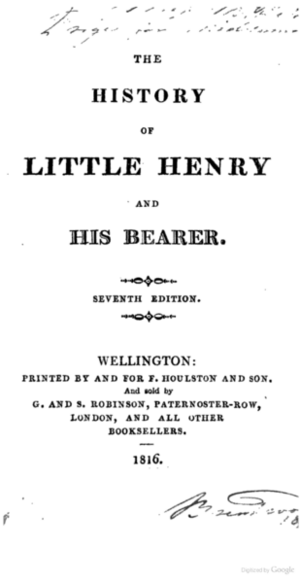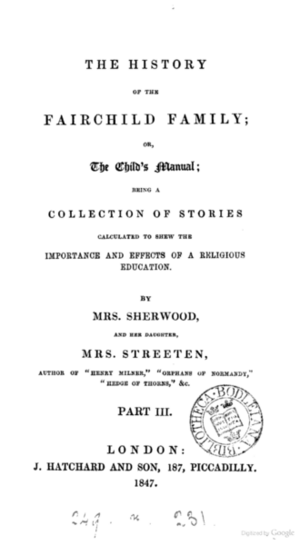Mary Martha Sherwood bibliography facts for kids

Mary Martha Sherwood (1775–1851) was a very popular English writer. She wrote many books for children, especially during the 1800s. Her stories often taught lessons about good behavior and Christian values. This page lists some of her most famous and important published works. It doesn't include her many articles written for magazines like The Youth's Magazine. This list is based on a special study by M. Nancy Cutt.
Contents
Mary Martha Sherwood's Published Works
Popular Books
Mary Martha Sherwood wrote many full-length books. These stories were often quite long and popular with families. Here are some of her most well-known titles:
This was one of her most famous books. It tells the story of a young English boy living in India and his Indian caretaker.
- The History of Susan Gray (1802, revised 1815)
This was an early and very popular story she wrote.
- The History of the Fairchild Family, Part I (1818)
This series is perhaps her most famous. It follows the adventures and moral lessons of the Fairchild children.
- The Infant's Progress from the Valley of Destruction to Everlasting Glory (1821)
This book was a children's version of a famous adult book called The Pilgrim's Progress.
- The History of Henry Milner, Part I (1822)
This was the first part of another popular series about a boy named Henry Milner.
- The Lady of the Manor (1823-1829)
This was a longer work, published in several parts over many years.
- Roxobel, or English Manners and Customs Seventy Years Ago (1830-1831)
This book looked back at how people lived in England many years before.
- The History of the Fairchild Family, Part II (1842)
The second part of her most famous series.
- The History of John Marten. A Sequel to the Life of Henry Milner (1844)
This book continued the story of Henry Milner.
- The History of the Fairchild Family, Part III (1847)
The final part of the popular Fairchild Family stories.
Here are some other notable books she wrote:
- The Traditions (1795)
- Margarita (1799)
- The History of Lucy Clare (1815)
- The Ayah and Lady (1816)
- An Introduction to Astronomy (1817)
- Stories Explanatory of the Church Catechism (1817)
- The History of Theophilus and Sophia (1818)
- The Indian Pilgrim (1818)
- An Introduction to Geography (1818)
- The Little Woodman and his Dog Caesar (1818)
- A General Outline of Profane History (1819)
- The Hedge of Thorns (1819)
- The Governess, or The Little Female Academy (1820)
- The History of George Desmond (1821)
- Mrs. Sherwood's Primer, or First Book for Children (1821)
- The Recaptured Negro (1821)
- Blind Richard (1821?)
- The Village Schoolmistress (1821?)
- The Orphans of Normandy, or Florentin and Lucie (1822)
- The History of Little Lucy and her Dhaye (1823)
- The Infant's Grave (1823)
- Père La Chaise (1823)
- The History of Mrs. Catharine Crawley (1824)
- The Bible Teacher's Manual (1824)
- My Uncle Timothy (1825)
- Clara Stephens (1825)
- Juliana Oakley (1825)
- The Captive of Ceylon (1826)
- The Soldier's Orphan, or The History of Maria West (1826)
- The History of Henry Milner, Part II (1826)
- The Gipsy Babes (1826)
- A Chronology of Ancient History (1826-1827)
- Susannah, or The Three Guardians (1827)
- Le Fevre (1827)
- Religious Fashion, or the History of Anna (1827)
- The Pulpit and the Desk (1827)
- The Birthday Present (1827)
- Arzoomund (1828)
- My Aunt Kate (1828)
- Southstone's Rock (1828)
- Theophilus (1828)
- Emancipation (1829)
- The Millennium, or Twelve Stories (1829)
- The Babes in the Wood of the New World (1830?)
- The Stranger at Home (1830?)
- Ermina (1831)
- The History of Henry Milner, Part III (1831)
- Scripture Prints with Explanations (1831)
- Dudley Castle (1832)
- The Nun (1833)
- The Latter Days (1833)
- The Little Momiére (1833)
- Victoria (1833)
- The Monk of Cimiés (1834)
- Sabbaths on the Continent (1835)
- Caroline Mordaunt, or The Governess (1835)
- The Old Cobler of the Cottage to which is added the Idler (1835)
- Shanty the Blacksmith (1835)
- Social Tales for the Young (1835)
- Biography Illustrated (1836)
- The Cloak to which is added the Quilting (1836)
- The History of Henry Milner, Part IV (1837)
- Sea-Side Stories (1838)
- The Little Girl's Keepsaid (1839)
- The Heron's Plume (1840-1847)
- The Fall of Pride (1840-1847)
- The White Pigeon (1840-1847)
- Martin Crook (1840-1847)
- Julietta di Lavenza (1841)
- The Juvenile Forget-me-Not (1841)

- The Holiday Keepsake (1841)
- The Joys and Sorrows of Childhood and The Loss of the Rhone (1841-1847)
- The Last Days of Boosy, the Bearer of Little Henry (1842)
- Robert and Frederick (1842)
- The Last Trunk and The Good Nurse (1844)
- Sunday Entertainment (1844-1858?)
- The De Cliffords (1847) - written with her daughter
- The Keepsake (1847) - not all stories are by Sherwood
- The Fairy Knoll (1848)
- The Story Book of Wonders (1849)
- The Golden Garland of Inestimable Delight (1849) - written with her daughter
- The Young Lord and Other Tales (1849-1850) - "Victorine Durocher" is by Sherwood and her daughter
- Green's Nursery Annual (1851) - "The Harvest Home" is by Sherwood
- The Two Knights (1851)
- Jamie Gordon, or The Orphan (1851)
- Brotherly Love (1851) - written with her daughter
- The Mirror of Maidens in the Days of Queen Bess (1851) - written with her daughter
- Home Stories for the Young (1852)
- Boys Will Be Boys, of The Difficulties of a Schoolboy's Life (1854) - written with her daughter
- The Golden City and Other Tales (1854-1862?) - written with her daughter
- The Greedy Boy, and Grateful Dog, and Other Tales (1854-1862?)
- Must I Learn, and Other Tales (1854-1862?)
- Grand-Aunt's Pictures (1854-1862?)
- William and Henry (1854-1862?)
- Mary and her Grandmama (1854-1862?)
- John and James (1854-1862?)
- My New Story Book (1861)
Chapbooks and Pennybooks
Chapbooks and pennybooks were small, inexpensive books. They were often sold by traveling sellers. Mary Martha Sherwood wrote many of these short stories.
- The History of Emily and her Brothers (1816)
- The History of Little George and his Penny (1816)
- The Busy Bee (1818)
- A Drive in the Coach through the Streets of London (1818)
- The Rose. A Fairy Tale (1818)
- The Errand Boy (1819)
- The Little Sunday School Child's Reward (1819)
- The Orphan Boy (1819)
- The Wishing Cap (1819)
- Little Arthur (1820)
- The May-Bee (1820)
- Little Robert and the Owl (1821)
- Easy Questions for a Little Child (1822)
- Julian Percival (1826)
- The Two Dolls (1826)
- The Dry Ground (1827)
- Edward Mansfield (1827)
- The Lady in the Arbour (1827)
- A Series of Questions and Answers Illustrative of the Church (1827)
- The Fawns (1828)
- The Hills (1828)
- Home (1828)
- Poor Burruff (1828)
- The Rainbow (1828)
- Soffrona and her Cat Muff (1828)
- The Rosebuds (1828)
- The Idiot Boy (1828)
- The Thunder Storm (1828)
- The Mourning Queen (1829)
- The Orange Grove (1829)
- Intimate Friends (1830)
- Katherine Seward (1830)
- The Hidden Treasure (1830?)
- A Mother's Duty (1830?)
- The Stolen Fruit (1830?)
- Everything Out of its Place (1831)
- A Visit to Grandpapa (1833?)
- The Bible (1838)
- The Happy Family (1838)
- The Little Negroes (1838)
- Lucy's Going to School (1840-1850)
- Horses and Coaches (1840-1850)
- Land of Snow (1840-1850)
- The Useful Dog (1840-1850)
- Dangerous Sport (1840-1850)
- Susan's First Money (1840-1850)
- The Flood (1840-1850)
- The Honey Drop (1840-1850)
- The Indian Chief (1840-1850)
- The Shawl (1840-1850)
- Eyes and Ears (1840-1850)
- Going to the Fair (1840-1850)
- How to Please (1840-1850)
- The Partin Cup (1840-1850)
- Yours is the Best (1840-1850)
- Willy Cary (1840-1850)
- Conceit Checked (1840-1850)
- What Could I Do Without Grandmother? (1840-1850)
- What's the Use of That? (1840-1850)
- Let Me Take Care of Myself (1840-1850)
- The Druids of Britain (1840-1850)
- The Blind Gentleman (1840-1850)
- The Child is but a Child (1840-1850)
- Comfort in Death (1840-1850)
- My Prize Book (1848-1862)
Religious Tracts
Religious tracts were small pamphlets or booklets. They were used to share religious messages. Mary Martha Sherwood wrote many of these to teach Christian lessons.
- The Infirmary (1817?)
- The Two Sisters (1819?)
- The Golden Clew (1820)
- The Nursery Maid's Diary (1820?)
- Procrastination, or The Evil of Putting Off (1820?)
- The Young Mother (1820?)
- The Iron Cage (1820?)
- Mary Anne (1820?)
- Abdallah, the Merchant of Bagdad (1820-1825?)
- The Fountain of Living Waters (1820-1825?)
- Charles Lorraine, or The Young Soldier (1821)
- The Young Forester (1821-1822?)
- The China Manufactory (1821-1822?)
- The Bitter Sweet (1822?)
- The Penny Tract (1822-1823?)
- The History of Mary Saunders (1822-1823?)
- The Blind Man and Little George (1822-1823?)
- The Potter's Commons, or The Happy Choice (1822-1823)
- The Poor Man of Colour, or The Sufferings (1822-1823)
- The Blessed Family (1823?)
- Common Errors (1822-1825?)
- Old Times (1823-1827?)
- Content and Discontent (1824)
- The Lambourne Bell (1824?)
- The Little Beggars (1824)
- Waste Not Want Not (1824)
- Joan, or Trustworthy (1826-1828?)
- The Cottage in the Wood (1826-1828?)
- The Turnpike House (1826-1828?)
- The Hop-Picking (1826-1830?)
- Do Your Own Work (1826-1830?)
- Do What You Can (1826-1830?)
- False Colours (1826-1830?)
- It Is Not My Business (1826-1830?)
- The Two Sisters, or Ellen and Sophia (1827)
- The Little Orphan (1829)
- Little Sally (1829)
- The Butterfly (1829)
- The Golden Chain (1829)
- The Red Book (1830)
- The Father's Eye (1830)
- The Mountain Ash (1830)
- Obedience (1830)
- The Two Paths, or The Lofty Way and The Lowly Way (1830)
- The Useful Little Girl and The Little Girl Who was of no Use at all (1830)
- The Flowers of the Forest (1830)
- The Oddingley Murders (1830)
- Sequel to the Oddingley Murders (1830)
- Hard Times (1830-1831)
- Emmeline (1832)
- Aleine, or Le Bächen Hölzli (1833)
- The Convent of St. Clair (1833)
- My Godmother (1833)
- The Ball and the Funeral (1833?)
- The Basket-Maker (1834-1835)
- The Red Morocco Shoes (1835)
- The Roman Baths, or The Two Orphans (1835)
- Saint Hospice (1835)
- The Violet Leaf (1835)
- The Last Request of Emily (1836)
- The Well-Directed Sixpence (1836)
- The School Girl (1836)
- The Parson's Case of Jewels (1837)
- The Indian Orphans (1839)
- The Garland. A Collection of Moral Tales (1835)
Collections of Her Works
Over the years, many of Mary Martha Sherwood's stories were gathered into larger collections. This made it easier for people to read many of her works together.
- The Works of Mrs. Sherwood by Harper & Bros. (1834-1857)
- Mrs. Sherwood's Popular Tales by Milner and Sowerby (1860)
- Mrs. Sherwood's Juvenile Tales by Milner and Sowerby (1861)
- The Lily Series by R. B. Carter & Bros. (1869)
- The Juvenile Library by Swan, Sonnenschein & Co. (1880)

